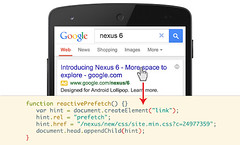Reactive prefetch speeds Google's mobile search by 100-150 milliseconds.

Increasing responsiveness by parallelizing and prefetching content using hints and dependency graphs, is an old concept, but seldom do we see such a nice tight example of the benefit as is given by the great Ilya Grigorik in this G+ post.
The insight here is that we're initiating the fetch for the HTML and its critical resources in parallel... which requires that the page initiating the navigation knows which critical resources are being used on the target page.
This is a powerful pattern and one that you can use to accelerate your site as well. The key insight is that we are not speculatively prefetching resources and do not incur unnecessary downloads. Instead, we wait for the user to click the link and tell us exactly where they are headed, and once we know that, we tell the browser which other resources it should fetch in parallel - aka, reactive prefetch!
As you can infer, implementing the above strategy requires a lot of smarts both in the browser and within the search engine... First, we need to know the list of critical resources that may delay rendering of the destination page for every page on the web! No small feat, but the Search team has us covered - they're good like that. Next, we need a browser API that allows us to invoke the prefetch logic when the click occurs: the search page listens for the click event, and once invoked, dynamically inserts prefetch hints into the search results page. Finally, this is where Chrome comes in: as the search results page is unloaded, the browser begins fetching the hinted resources in parallel with the request for the destination page. The net result is that the critical resources are fetched much sooner, allowing the browser to render the destination page 100-150 milliseconds earlier.




